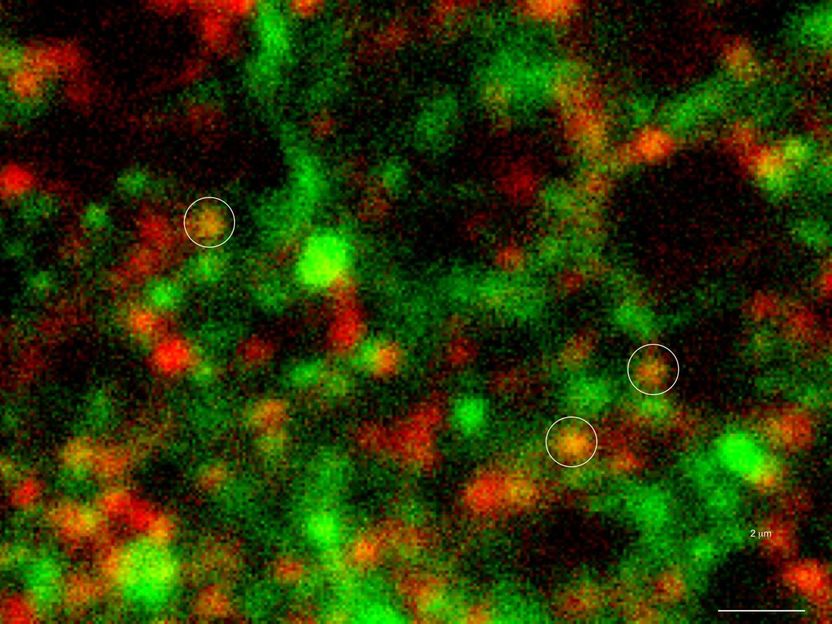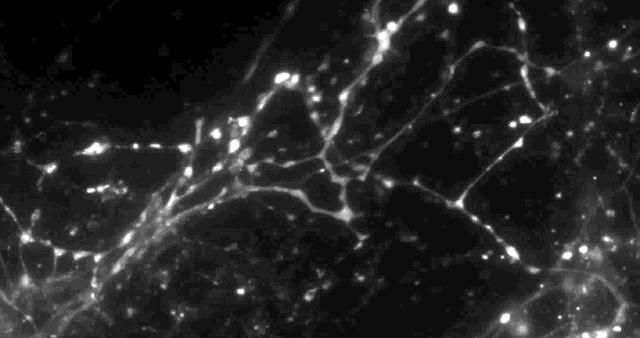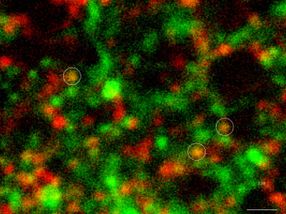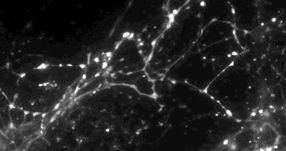Only a small portion of synapses may be active during neurotransmission
Columbia University scientists have developed a new optical technique to study how information is transmitted in the brains of mice. Using this method, they found that only a small portion of synapses -- the connections between cells that control brain activity--may be active at any given time.

Only 20 percent of synapses (red) were observed to transmit dopamine. The rest (green) were found to be silent.
Sulzer Lab/Columbia University Medical Center

The FFN200 fluorescent molecule tracking neurotransmission of dopamine in mouse synapses.
Sulzer Lab/Columbia University Medical Center


"Understanding how we accomplish complex tasks, such as learning and memory, requires us to look at how our brains transmit key signals -- called neurotransmitters -- across synapses from one neuron to another," said David Sulzer, PhD, professor of neurobiology in Psychiatry, Neurology, and Pharmacology at Columbia University Medical Center (CUMC). "Older techniques only revealed what was going on in large groups of synapses. We needed a way to observe the neurotransmitter activity of individual synapses, to help us better understand their intricate behavior."
To obtain a detailed view of synaptic activity, Sulzer's team collaborated with the laboratory of Dalibor Sames, PhD, associate professor of chemistry at Columbia, to develop a novel compound called fluorescent false neurotransmitter 200 (FFN200). When added to brain tissue or nerve cells from mice, FFN200 mimics the brain's natural neurotransmitters and allows researchers to spy on chemical messaging in action.
Using a fluorescence microscope, the researchers were able to view the release and reuptake of dopamine -- a neurotransmitter involved in motor learning, habit formation, and reward-seeking behavior -- in individual synapses. When all the neurons were electrically stimulated in a sample of brain tissue, the researchers expected all the synapses to release dopamine. Instead, they found that less than 20 percent of dopaminergic synapses were active following a pulse of electricity.
"Why are there these large reservoirs of synapses that are silent?" said Dr. Sames, a co-author of the paper. "Perhaps these silent terminals hint at a mechanism of information coding in the brain that's yet to be revealed."
The study's authors plan to pursue this hypothesis in future experiments, as well as examine how other neurotransmitters behave.
"This particular study didn't explain what's causing most of the synapses to remain silent," said Dr. Sulzer. "If we can work this out, we may learn a lot more about how alterations in dopamine levels are involved in brain disorders such as Parkinson's disease, addiction, and schizophrenia."
Original publication
Daniela B Pereira, Yvonne Schmitz, József Mészáros, Paolomi Merchant, Gang Hu, Shu Li, Adam Henke, José E Lizardi-Ortiz, Richard J Karpowicz Jr, Travis J Morgenstern, Mark S Sonders, Ellen Kanter, Pamela C Rodriguez, Eugene V Mosharov, Dalibor Sames & David Sulzer; "Fluorescent false neurotransmitter reveals functionally silent dopamine vesicle clusters in the striatum"; Natrue Neuroscience; 2016
Most read news
Original publication
Daniela B Pereira, Yvonne Schmitz, József Mészáros, Paolomi Merchant, Gang Hu, Shu Li, Adam Henke, José E Lizardi-Ortiz, Richard J Karpowicz Jr, Travis J Morgenstern, Mark S Sonders, Ellen Kanter, Pamela C Rodriguez, Eugene V Mosharov, Dalibor Sames & David Sulzer; "Fluorescent false neurotransmitter reveals functionally silent dopamine vesicle clusters in the striatum"; Natrue Neuroscience; 2016
Other news from the department science

Get the analytics and lab tech industry in your inbox
From now on, don't miss a thing: Our newsletter for analytics and lab technology brings you up to date every Tuesday. The latest industry news, product highlights and innovations - compact and easy to understand in your inbox. Researched by us so you don't have to.


![[Fe]-hydrogenase catalysis visualized using para-hydrogen-enhanced nuclear magnetic resonance spectroscopy](https://img.chemie.de/Portal/News/675fd46b9b54f_sBuG8s4sS.png?tr=w-712,h-534,cm-extract,x-0,y-16:n-xl)





















































